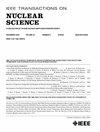Real-Time Digital-Twin of Thorium-Based Molten Salt Breeder Reactor for Closed-Loop Controller Testing Applications
IF 1.9
3区 工程技术
Q3 ENGINEERING, ELECTRICAL & ELECTRONIC
引用次数: 0
Abstract
Molten salt breeder reactors (MSBRs), which utilize molten fluoride salts as both fuel and coolant, are currently being researched and designed worldwide, offering inherent safety features, efficient fuel utilization, and the potential for thorium-based fuel cycles. Given the advanced development status of MSBRs, real-time emulation is essential for dynamic analysis studies, accommodating more detailed models and advanced control strategies. This article proposes a real-time digital-twin (RTDT) based on a hardware-in-the-loop (HIL) emulation on a field-programmable gate array (FPGA) for a multi-domain two-fluid MSBR model with a designed controller for validation and testing. A nonlinear explicit numerical solution with an appropriate step-size and ordinary differential equation (ODE) solver is carried out in a non-iterative fashion to achieve the required accuracy and real-time execution. The MSBR hardware emulation and closed-loop controller tests have been implemented on the parallel hardware architecture of the FPGA in real-time for dynamic analysis and performance evaluation. The FPGA-based hardware emulation has achieved an ultralow latency of基于钍基熔盐增殖反应堆闭环控制器测试应用的实时数字孪生
熔盐增殖反应堆(MSBRs)利用熔融氟化物盐作为燃料和冷却剂,目前正在世界范围内进行研究和设计,具有固有的安全特性、高效的燃料利用以及钍基燃料循环的潜力。鉴于msbr的先进发展状况,实时仿真对于动态分析研究至关重要,可以提供更详细的模型和先进的控制策略。本文提出了一种基于现场可编程门阵列(FPGA)硬件在环(HIL)仿真的实时数字孪生(RTDT),用于多域双流体MSBR模型,并设计了用于验证和测试的控制器。采用非迭代的方式,采用适当的步长和常微分方程(ODE)求解器进行非线性显式数值解,以达到所需的精度和实时性。在FPGA的并行硬件架构上进行了MSBR硬件仿真和闭环控制器测试,实时进行了动态分析和性能评估。基于fpga的硬件仿真实现了2.34~ $ $ s的超低延迟,提供了427倍的超实时(FTRT)性能加速。在RTDT上验证了所设计的控制器在瞬态和稳态运行条件下的良好性能,有效地稳定了MSBR系统在摄动下的稳定性。
本文章由计算机程序翻译,如有差异,请以英文原文为准。
求助全文
约1分钟内获得全文
求助全文
来源期刊

IEEE Transactions on Nuclear Science
工程技术-工程:电子与电气
CiteScore
3.70
自引率
27.80%
发文量
314
审稿时长
6.2 months
期刊介绍:
The IEEE Transactions on Nuclear Science is a publication of the IEEE Nuclear and Plasma Sciences Society. It is viewed as the primary source of technical information in many of the areas it covers. As judged by JCR impact factor, TNS consistently ranks in the top five journals in the category of Nuclear Science & Technology. It has one of the higher immediacy indices, indicating that the information it publishes is viewed as timely, and has a relatively long citation half-life, indicating that the published information also is viewed as valuable for a number of years.
The IEEE Transactions on Nuclear Science is published bimonthly. Its scope includes all aspects of the theory and application of nuclear science and engineering. It focuses on instrumentation for the detection and measurement of ionizing radiation; particle accelerators and their controls; nuclear medicine and its application; effects of radiation on materials, components, and systems; reactor instrumentation and controls; and measurement of radiation in space.
 求助内容:
求助内容: 应助结果提醒方式:
应助结果提醒方式:


